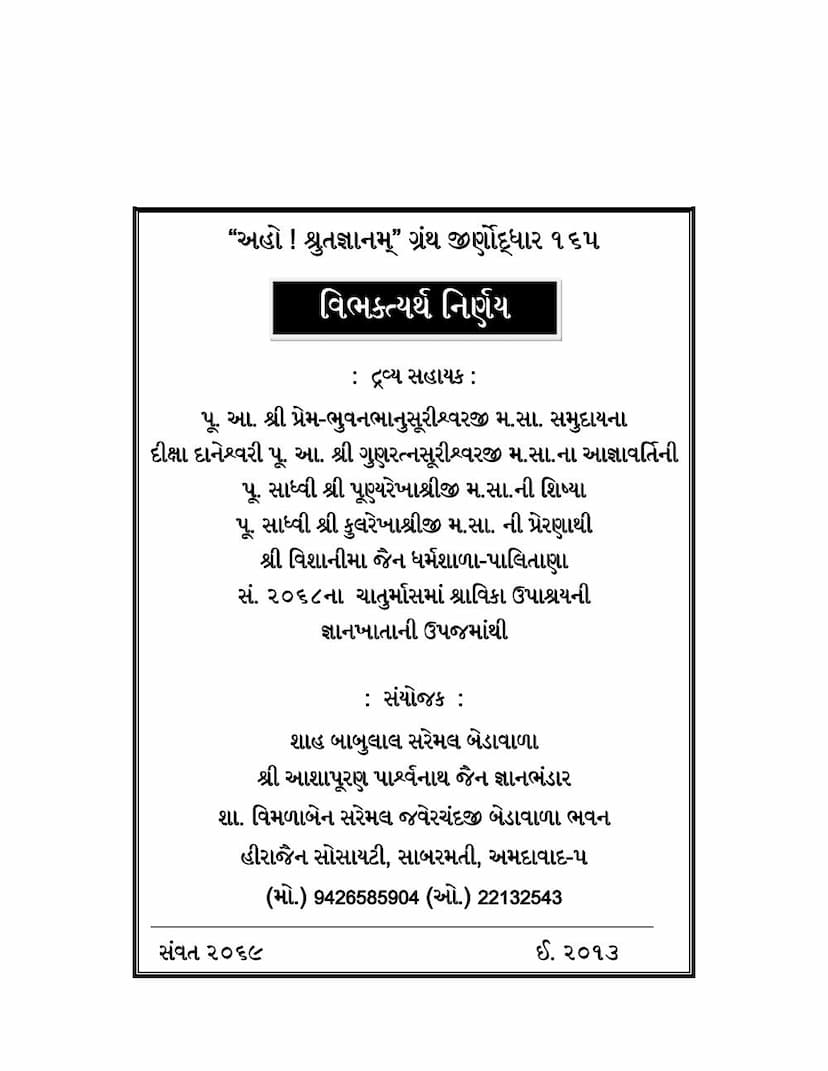Vibhakatartha Nirnay
Added to library: September 2, 2025

Summary
Here's a comprehensive summary of the Jain text "Vibhakatartha Nirnay" by Girdhar Jha and Jivnath Mishra, based on the provided pages:
Title: Vibhakatartha Nirnay (विभक्त्यर्थ निर्णय) Authors: Girdhar Jha (गिरिधर झा), Jivnath Mishra (जीवनाथ मिश्र) Publisher: Chaukhambha Sanskrit Series Office Catalog Link: https://jainqq.org/explore/034214/1
Overview:
The provided text is a scanned copy of the Jain philosophical and grammatical work, "Vibhakatartha Nirnay," focusing on the meanings and usages of grammatical cases (Vibhakti) in Sanskrit, particularly within the context of Jain philosophy and linguistics. The book was published by Chaukhambha Sanskrit Series Office. The scanned pages reveal that this is a scholarly edition, meticulously researched and presented.
Key Aspects and Content:
-
Purpose and Scope:
- The book aims to provide a detailed and accurate determination of the meaning of grammatical cases (Vibhakti).
- It delves into the nuances of the seven cases (Prathama to Saptami) and their application.
- The authors, Girdhar Jha and Jivnath Mishra, meticulously analyze the grammatical rules and philosophical implications.
-
Authors and Scholars:
- Girdhar Jha (Giridhar Upadhyay): Identified as the original author (प्रणेता), he was a Mahopadhyaya (महोपाध्याय) from Mithila, hailing from the village Magrauli. He received his education from Shri Gokulnath Upadhyay, who was a contemporary of his father. Girdhar Jha's own writing in the text ("इति पदद्वाक्यरत्नाकरेऽस्मदूगुरुचरणा" - "thus in Pad Vakya Ratnakar, our guru's feet") highlights his lineage of scholarship and his respect for his guru. His work is dated to around the 16th century (1600s CE).
- Jivnath Mishra (Jivnath Mishra): He is credited as the scholar (शोधक/परिशोधित) who researched, edited, and refined the text for publication. He holds the title "Tarkateerth Nyayaratna" (तर्कतीर्थन्यायरत्न). His preface (भूमिका) indicates his dedication to bringing this ancient and valuable text to light, emphasizing its depth, comprehensiveness, and scholarly rigor.
-
"Aho! Shrutgyanam" Project:
- The project "Aho! Shrutgyanam Granth Jirnoddhar" (अहो ! श्रुतज्ञानम् ग्रंथ जीर्णोद्धार) is prominently featured. This initiative, supported by various Jain trusts and individuals (like Shri Ashapuran Parshwanath Jain Gyanbhandar, initiated by Shri Vishanimata Jain Dharmashala, Palitana), is dedicated to digitizing, scanning, and creating DVDs of rare and ancient Jain manuscripts that are otherwise difficult to access.
- "Vibhakatartha Nirnay" is part of this larger project, with sets being released over several years (Svt. 2065/2009 to Svt. 2075/2019), indicating the ongoing effort to preserve and disseminate these valuable texts. The specific volume being summarized is dated Svt. 2069 (2013 CE).
-
Content and Methodology:
- The book systematically explains the grammatical rules pertaining to each case (Vibhakti), often referencing and discussing the views of prominent Grammarians and Philosophers like Panini, Patanjali (Mahabhashya), Katyayana (Varttika), and various Nyaya and Mimamsa schools.
- It analyzes the role of suffixes (Pratyaya) and their relationship with the root words (Dhatu) and case endings (Subanta, Tinanta).
- A significant portion is dedicated to the intricate analysis of Vibhakti (case endings) and their semantic and grammatical functions, especially in relation to verbs (Kriya) and nouns (Nama).
- The "Bhumika" (Preface) by Jivnath Mishra discusses the importance and unique qualities of the "Vibhakatartha Nirnay," highlighting its depth, clarity, and the author's (Girdhar Jha's) insightful way of presenting arguments and refuting opposing views.
- The Shuddhipatra (Errata) on page 15 shows the meticulous process of correction and refinement undertaken for the printed text.
-
Grammatical and Philosophical Analysis:
- The text engages in deep grammatical analysis, questioning and refining the definitions of concepts like "Karaka" (agent/doer) and "Sambandha" (relationship).
- It explores the relationship between grammatical cases and philosophical concepts, such as the nature of actions, causality, and perception.
- Discussions revolve around whether a case ending's meaning is intrinsic (Svartha) or derived from its relation to other words in the sentence, particularly the verb.
- The authors meticulously dissect the subtleties of Sanskrit grammar, drawing upon various schools of Indian philosophical thought, including Nyaya, Mimamsa, and general linguistic theories.
In essence, "Vibhakatartha Nirnay" is a profound grammatical treatise that uses the framework of Sanskrit grammar to explore the deeper philosophical and linguistic structures of meaning, particularly as understood in the Jain tradition. It's a testament to the rigorous analytical approach of Indian scholarship in understanding language and its connection to reality. The "Aho! Shrutgyanam" project ensures that such vital scholarly works reach a wider audience through digitization and accessibility.